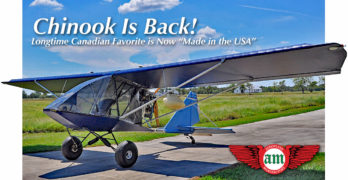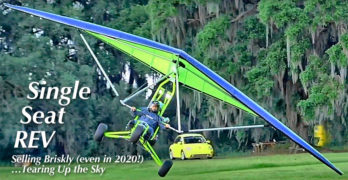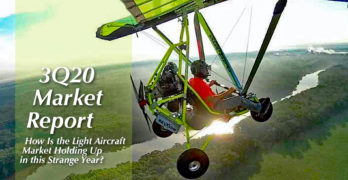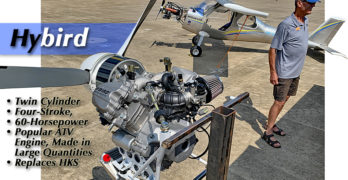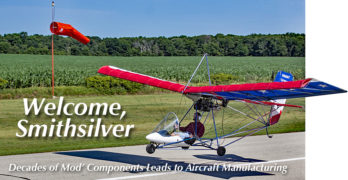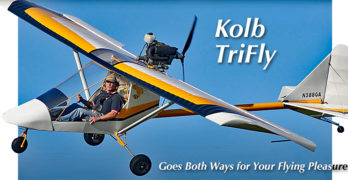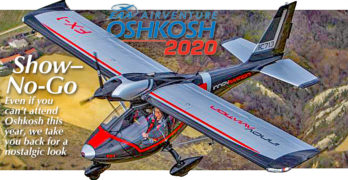Then…
In the 1990s, a pair of Canadian aircraft dominated the light aviation market in America’s neighbor to the north. The two planes are known to many Americans: Beaver and Chinook.
Thanks to a rescue by second owner ASAP many years ago, both continued to be manufactured in Canada’s West.
Long-departed Birdman Enterprises did a fine job of originating the Chinook. When ASAP took over, Canadians and ultralight enthusiasts in many places celebrated ongoing support of this aircraft. Hundreds of Chinooks were built.
That is now rather distant history. Bringing Chinook not only into the present day but also into the USA is the Aeroplane Manufactory.
…and Now
For several years, ASAP sold the Chinook Plus 2, tagging the two-seater model with the “Plus” suffix after ASAP’s team improved and refined the aircraft following their acquisition.
In more modern times, after purchasing the Chinook design rights and inventory in 2013 (five semi loads’ worth!), Aeroplane Manufactory brought the north-of-the-border design way down south to the Houston, Texas area.
Search Results for : Part 103
Not finding exactly what you expected? Try our advanced search option.
Select a manufacturer to go straight to all our content about that manufacturer.
Select an aircraft model to go straight to all our content about that model.
All Revved Up — Succeeding Brilliantly in 2020; Flying for Fun Defies Covid-19
You can see market numbers for the last quarter in this article — or review all LSA and Sport Pilot kit market info in this dedicated area. Get results for every American light aircraft on Tableau Public.
If you read the recent article closely, you saw that not only are single seat aircraft enjoying good sales but Part 103 ultralights may be going stronger than in many years …possibly the best ever. I wish we could report 103 ultralight market shares but as they do not have to register with (and get an N-number from) FAA, we have no third-party way to evaluate the numbers accurately.
Add the U.S. experience of the last year or three to overseas sales activity and I think most aviators around the world might be amazed at the strength of this market. Certainly, this is an under-reported category.
Up or Down? How Flies the Light Aircraft Industry in this Strange Year?
By any measure 2020 has been an unusual year. While millions were thrown out of work by lockdowns to prevent the virus from spreading, we all read or hear that plenty of other workers can work from home or have businesses that cannot be restricted by government decrees.
In this context, how might the aviation industry be holding up? We read — and some brave travelers have experienced first-hand — how the airline industry is in a deep hole, prompting large layoffs.
In this third quarter report for the calendar year, I’ll look at some numbers for general aviation manufacturers as well as the light aviation industry that has my full focus.
The short answer: some are doing surprisingly well.
Light-Sport Aircraft
Before I launch into an analysis, I must extend grateful thanks to Datastician Extraordinaire, Steve Beste, who does such a comprehensive job compiling and demystifying data from FAA’s aircraft registration database.
Welcome Hybird — New Four-Stroke Engine for Light Aircraft; Replaces HKS
A new engine was debuted at Midwest LSA Expo 2020 for light aircraft from Aeromarine-LSA. Paired as it is with a new engine-specific prop, this is a refreshing bit of news for ultralight enthusiasts and other single seat light aircraft lovers.
It’s called Hybird… and, no, I did not spell that incorrectly. As you’ll hear, the new powerplant has some possibility to be a form of hybrid (this time spelled as you expect) but it is different in that respect, too.
Since HKS decided to exit airplane engines — although our favorite datastician, Steve Beste reports he can still get parts for his HKS — the light aircraft industry has had an ear to the ground for a new four stroke replacement. It appears Chip Erwin has what many are seeking.
HyBIRD, not Hybrid
As those who know him realize, Chip does not just go out and find components for his airplanes and then adapt them to his designs.
Did It Work? Midwest Light-Sport Expo 2020 — the Year’s Final Airshow
Lots of doubters expressed their opinions in the weeks and days before Mt. Vernon’s 12th running of this sector-specific event. Did it work? Were the naysayers right or wrong?
I will express one person’s opinion but reflect a number of comments I heard: “Thank goodness for Mt. Vernon airport manager Chris Collins and his contingent of orange-shirted volunteers who hosted this event,” making it another success.
To me, “success” means no accidents (none happened) and a decent turn-out that got pilots in new aircraft and vendors the sales that sustain them (both happened).
Summarizing Midwest 2020
In a typical year, Midwest attracts 1,500 or more pilots for the three days of event. My casual estimate is that 2020 was at least as strong as before and perhaps it was even up a bit. No one knows more. Midwest does not charge a fee to enter and more than one entry gate would make any effort to count heads futile.
Tri-State Kites — Midwestern America Developer of the Smithsilver Ultralight Aircraft
If you know light, recreational aviation, you simply must know the Quicksilver brand. The Southern California company made a fantastic splash in the early 1980s, outselling in one year more total units than Cessna, Piper, and Beech combined! I’m guessing a good percentage of readers have taken a flight in one of their models. More than 15,000 were sold. They are still available and Air-Tech Inc offers full support plus new kits.
This story isn’t about that famous brand.
To most who glance at the nearby photos your first instinct is see a Quicksilver. A closer inspection shows otherwise. I spoke with leaders of Tri-State Kites — Andy Alldredge and Tom Smith, representing the second generation of Mark Smith’s operation. Mark Smith passed away in 2015.
Legendary Tri-State Kites*
To a large network headquartered in Mt. Vernon, Indiana, Mark Smith is something of a legend. Known for continually improving his airplanes, he was always inventing and innovating.
UltraChoppers — Exploring Two Light Rotary-Winged Aircraft: 1 Helo + 1 Gyro
➡️ This article was UPDATED on July 31, 2020 with additional information — see after video…
Some pilots love to whirl their wings over their heads. Many others like the idea of rotary flight — offering short takeoffs and landings plus ease of operation in windier conditions. A majority have not (yet) acted on their interest but perhaps they are waiting for the right aircraft, maybe one of these.
One is a very light coaxial helicopter from Russia. The other is a single place gyroplane from Poland.
Micron-3 Coaxial Helicopter
Have a glance at the RD Heli’s Micron-3 ultralight helicopter. This is like no other ultralight helicopter I’ve ever seen, although the idea of coaxial is not new.
History suggests coaxial rotors originated with Mikhail Lomonosov a very long time ago, according to Wikipedia. Over the years, many helicopter models have emerged but none so compact as Micron-3
Coaxial rotors are a pair of helicopter rotors mounted one above the other driven by concentric driveshafts, with the same axis of rotation, but turning in opposite directions (contra-rotating; see graphic).
Try and Fly TriFly — Kolb’s Wonderful Single Seat Light Aircraft Goes Both Ways
Some pilots are wary of taildraggers. This is hardly surprising since only tricycle-gear aircraft have been used in primary flight instruction dating back into the 1970s. Most pilot have no experience with taildraggers but nearly all have heard of the dreaded ground-loop tendency such gear configuration can allow.
Indeed, when investigating insurance for a taildragger, you will have to prove you have some experience or get training from a suitably-experienced instructor — and you won’t find many able to help you.
How about if an aircraft went both ways? What if an affordable aircraft allowed you to fly with tricycle gear but permitted you to practice your taildragger technique yet still use the nosewheel’s self-straightening capability if you start to get a little “sideways” (literally or figuratively)?
Kolb Aircraft has an answer.
Kolb TriFly
Producers of Part 103 aircraft, such as Kolb Aircraft report consistently strong business for the last few years.
Back to the Future… Let’s Go to Oshkosh (OK, from last year) for a Full Tour of Light Aircraft
It’s almost July and any active pilot knows what that means: Oshkosh! Except not this year. ☹️
I interrupt the ongoing battle with Covid-19 to take you on a nostalgic tour of Oshkosh-19. View this excursion by video below.
Hey, when you can’t go to EAA AirVenture Oshkosh 2020, why not simulate from the safety and comfort of your home or backyard? Just like Netflix urges you — “Watch It Again!”
This brief virtual tour of aircraft and people from AirVenture last year may have you wishing you were starting to pack your bags for the big show this year …sigh!…
Oshkosh Redux
Sometimes called “Disneyland for Airplanes,” if you like things that fly — whatever form they take — you can probably find it at Oshkosh. Like a kid in a candy store, everywhere you look offers sweet temptations.
Oshkosh is so sprawling you can’t see it all but this post along with the video below tries to capture objects of interest to readers of this website and viewers of Dave’s “The Ultralight Flyer” YouTube Channel.
American Ranger AR1 Gyroplane Embraces Rotax 915iS Power
You can call modern gyroplanes “wanna-be” helicopters if you want but that might miss a few important points.
First, a gyroplane can be flown by a Sport Pilot. Other than Part 103 ultralight version, a helicopter requires a higher certificate and that means a medical, at least BasicMed.
LAMA believes gyroplanes will be included in FAA’s revised LSA regulation from what is known at this time. That means they’ll be available ready-to-fly and prices are so much less than conventional helicopters that it’s not even comparable. Comparing the most deluxe fully-built gyroplane to even a used helicopter is a world apart. Finally, maintenance of a gyroplane is dramatically less than any helicopter.
Despite those differences, gyroplanes enjoy some of the same performance capabilities of a helicopter — other than vertical launch. Gyroplanes also work unusually well in wind conditions that might ground most other aircraft.
No wonder gyroplanes have enjoyed a huge run in space-tight European countries and have been growing steadily in the USA.
- « Previous Page
- 1
- …
- 15
- 16
- 17
- 18
- 19
- …
- 53
- Next Page »


